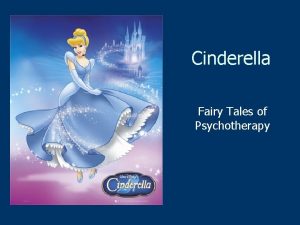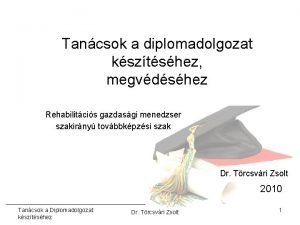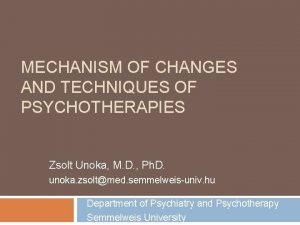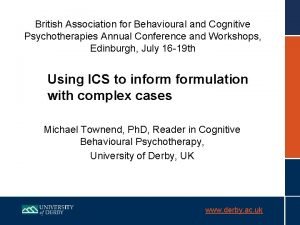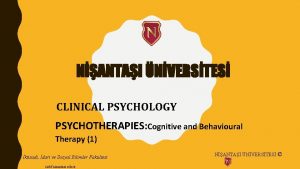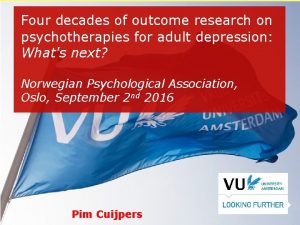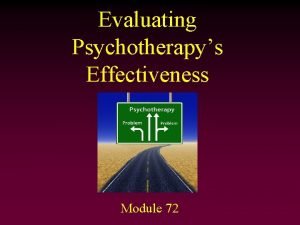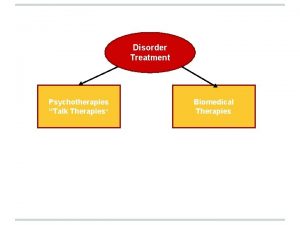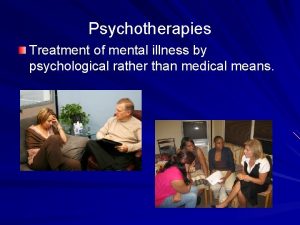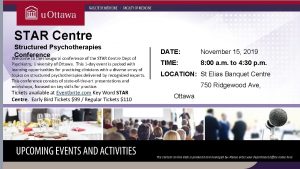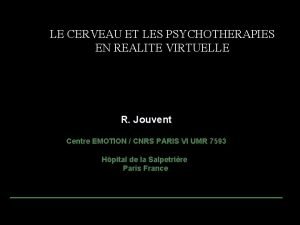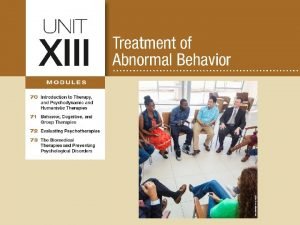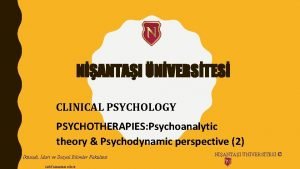MECHANISM OF CHANGES AND TECHNIQUES OF PSYCHOTHERAPIES Zsolt

















- Slides: 17

MECHANISM OF CHANGES AND TECHNIQUES OF PSYCHOTHERAPIES Zsolt Unoka, M. D. , Ph. D. unoka. zsolt@med. semmelweis-univ. hu Department of Psychiatry and Psychotherapy Semmelweis University

Psychotherapy is an effective treatment many meta-analyses and even meta-metaanalysis show an effect size of approximately 0. 8 a ‘strong’ effect size in the social sciences this makes psychotherapy more potent than many well established EBM procedures including (for example) almost all interventions in asthma, geriatric medicine and cardiology (Wampold, 2007).

Factors Influencing Psychotherapy Outcome (Lambert & Barley, 2002) Common Factors (30%) � � Expectancy Effects (15%) � � Placebo effects The Dodo bird hypothesis Specific therapy techniques (15%) � Alliance Relationship with therapist Support Hopefulness Systematic desensitisation, dream analysis, role play, etc. Extratherapeutic factors (40%) � � � Spontaneous recovery or remission Fortunate events Social support

Common factors or non-specific curative factors in psychotherapy “…decades of research consistently demonstrate that relationship factors correlate more highly with client outcome than do specialized treatment techniques… therapists need to remember that the development and maintenance of therapeutic relationship is a primary curative component of therapy and that the relationship provides the context in which the specific techniques exert their influence. ” - Lambert & Barley (2001) Psychotherapy, 38(4): 357 -361

Common factors or non-specific curative factors in psychotherapy Working alliance: � Goals: Objectives of therapy that both client and therapist endorse � Tasks: Behaviors and processes within therapy session that leads to the goal � Bonds: The positive interpersonal attachment between therapist and client of mutual trust, confidence, and acceptance Patient rated alliance is the best predictor of effectiveness and drop-out.

Client-centered therapy is a common factor therapy It’s specific factors are the common factors of psychotherapy: � � � Congruence - the willingness to transparently relate to clients without hiding behind a professional or personal facade. Unconditional Positive Regard - therapist offers an acceptance and prizing for their client for who he or she is without conveying disapproving feelings, actions or characteristics and demonstrating a willingness to attentively listen without interruption, judgement or giving advice. Empathy - therapist communicates their desire to understand appreciate their clients perspective.

Psychoanalysis The goal: Since psychological problems originate from childhood repressed impulses and conflicts, the aim of psychoanalysis is to bring repressed feelings into conscious awareness where the patient can deal with them.

Psychoanalysis Focus on expression of emotion Exploration of distressing experience Identification of recurring themes Discussion of development Focus on interpersonal relations Focus on therapy relationship Exploration of fantasy life (Shedler, 2010).

Behaviour therapy Assumptions of psychopathology: People learn their problems Problems occur naturally through a learning process � Classical e. g. , phobias � Operant conditioning (Skinner) e. g. , Substance abuse, Personality disorders, depression � Modell conditioning (Pavlov) learning (Bandura) Problems are sustained largely through escape and avoidance of aversive events

Behaviour therapy Assumptions of curative factors If problems are learned, new and more effective behaviors can be learned as well Mechanism: � � exposure extinction classical and operant conditioning modell learning Techniques � � � Systematic desensitization (Wolpe) Graduated exposure treatments Flooding

Cognitive therapy Albert Ellis and Aaron T. Beck Assumptions of psychopathology � Thoughts are the cause of our problems � Way we think about the world dictates how we feel about ourselves, others, and the future � This is a cognitive triad � Depressed people have a negative cognitive triad � Combined with logical errors � get depressed

Cognitive therapy Assumptions of curative factors Need to identify dysfunctional core schema and replace with more accurate and effective schema Need to challenge the cognitive distortions or false beliefs with evidence and look for more accurate thoughts Techniques � Identify irrational beliefs, maladaptive interpretations of events � Challenge beliefs directly � Encourage more rational beliefs and interpretations

Family therapy Assumptions of psychopathology: Dysfunctional family system Assumption of curative factors: Family therapy treats the family as a system. Therapy guides family members toward positive relationships and improved communication.

Curative factors in group therapy(Yalom, 2005) Universality The recognition of shared experiences and feelings among group members and that these may be widespread or universal human concerns, serves to remove a group member's sense of isolation, validate their experiences, and raise self-esteem Altruism The group is a place where members can help each other, and the experience of being able to give something to another person can lift the member's self esteem and help develop more adaptive coping styles and interpersonal skills. Instillation of hope In a mixed group that has members at various stages of development or recovery, a member can be inspired and encouraged by another member who has overcome the problems with which they are still struggling. Imparting information While this is not strictly speaking a psychotherapeutic process, members often report that it has been very helpful to learn factual information from other members in the group. For example, about their treatment or about access to services. Corrective recapitulation of the primary family experience Members often unconsciously identify the group therapist and other group members with their own parents and siblings in a process that is a form of transference specific to group psychotherapy. The therapist's interpretations can help group members gain understanding of the impact of childhood experiences on their personality, and they may learn to avoid unconsciously repeating unhelpful past interactive patterns in present-day relationships. Development of socializing techniques The group setting provides a safe and supportive environment for members to take risks by extending their repertoire of interpersonal behaviour and improving their social skills

Curative factors in group therapy (Yalom, 2005) Imitative behaviour One way in which group members can develop social skills is through a modeling process, observing and imitating therapist and other group members. For example, sharing personal feelings, showing concern, and supporting others. Cohesiveness It has been suggested[3] that this is the primary therapeutic factor from which all others flow. Humans are herd animals with an instinctive need to belong to groups, and personal development can only take place in an interpersonal context. A cohesive group is one in which all members feel a sense of belonging, acceptance, and validation. Existential factors Learning that one has to take responsibility for one's own life and the consequences of one's decisions. Catharsis is the experience of relief from emotional distress through the free and uninhibited expression of emotion. When members tell their story to a supportive audience, they can obtain relief from chronic feelings of shame and guilt. Interpersonal learning Group members achieve a greater level of self-awareness through the process of interacting with others in the group, who give feedback on the member's behaviour and impact on others. Self-understanding This factor overlaps with interpersonal learning but refers to the achievement of greater levels of insight into the genesis of one's problems and the unconscious motivations that underlie one's behaviour.

Principles of interventions Strategy Long term goals Tactics Tasks of the session Techniques Moment to moment Yeomans, Clarkin, Kernberg 2002. alapján

THANK YOU!
 3 commonalities among psychotherapies
3 commonalities among psychotherapies 3 commonalities among psychotherapies
3 commonalities among psychotherapies Cinderella therapy
Cinderella therapy Changes in latitudes, changes in attitudes meaning
Changes in latitudes, changes in attitudes meaning Chemical change examples
Chemical change examples Hellner szelina
Hellner szelina Gilányi zsolt
Gilányi zsolt Kosztyán zsolt
Kosztyán zsolt Dr völgyi zoltán pápa
Dr völgyi zoltán pápa Egri zsolt
Egri zsolt Petke zsolt
Petke zsolt Beke zsolt
Beke zsolt Heller zsolt
Heller zsolt Dr törcsvári zsolt
Dr törcsvári zsolt Johanyák zsolt csaba
Johanyák zsolt csaba Mintzberg vezetői szerepek
Mintzberg vezetői szerepek Makleit zsolt
Makleit zsolt Paróczi zsolt
Paróczi zsolt


